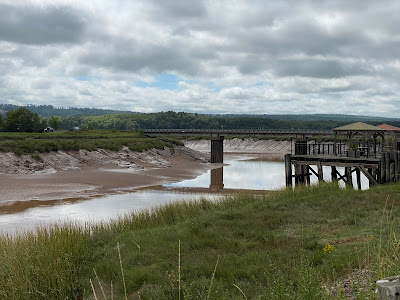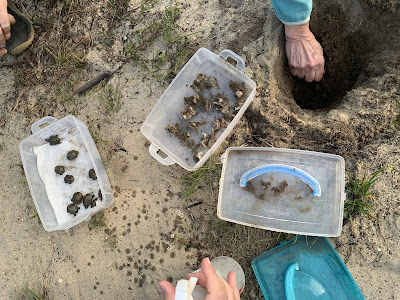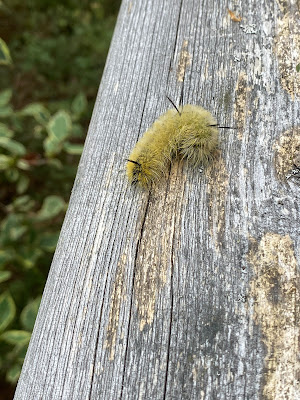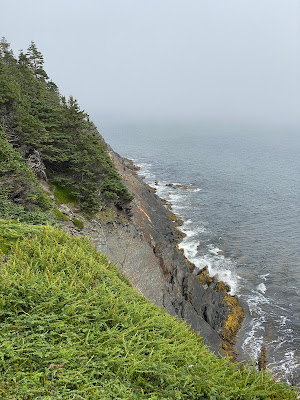September 2023: Fundy Tides, Sandpipers, Trolls, Diamondback Terrapins
Sunday September 3 We set off on a driving trip to Nova Scotia to see my friends Pete and Trish, who I've known since my days in graduate school in Cambridge; Pete was one of my weekly squash partners there. On the way home we plan to stop at Acadia National Park and Boothbay Harbor in Maine.
Monday September 4 At one of the highway rest stops in Nova Scotia, near the tip of the Bay of Fundy, we spotted this sign.
The huge tides in the Bay of Fundy produce extensive mud flats in the Minas Basin, the southern fork at the tip of the Bay, providing migrating shorebirds, especially sandpipers, an ideal stopover to fatten up on invertebrates before continuing their journey. One to two million shorebirds stop over on their way south in July and August. And although we're now at the tail end of shorebird migration season, I'm hoping to see some on this trip.
At Truro, we stopped to see the tidal bore, a wave of water that rushes upstream in narrows as high tide begins to come in. The day we were there, the wave wasn't all that impressive, but we're told it's sometimes several feet high. As it came around a bend in the river, the Nova Scotia tourist information staff person gave out a loud shout to let everyone know it was coming, which we found quite amusing.
Wednesday September 6 We're staying at Pete and Trish's home at Martin's Point on the beautiful south shore, about an hour from Halifax. Saw this dagger moth caterpillar on their stair railing. Found out later that the long black "daggers" are poisonous. Yikes.
Drizzly day so we drove along the shore to Lunenburg and then on to Blue Rocks.
Thursday September 7 Susan wanted to see the Bay of Fundy tides in action so we went up to the Wolfville area for the day today. We had lunch at The Port restaurant, on the Cornwallis River, right at low tide, and came back around 5pm and again at high tide at 7:50pm. Here's what it looked like, looking east and west along the river.
 |
| Low tide, looking east, 1:18pm |
 |
| High tide, looking east, 7:50pm |
 |
| Low tide, looking west, 1:18pm |
 |
| Mid-tide, looking west, 5:03pm |
 |
| High tide, looking west, 7:50pm |
The water rose 30 feet (9.25 meters) between low and high tides; I was amazed at how high up the bridge the water came.
Evangeline Beach near Wolfville is the most important roost for migrating semipalmated sandpipers in the Minas Basin. The birds are on their way from their breeding grounds along the shores of the Arctic Ocean and Hudson's Bay to their wintering grounds in the Caribbean and South America. Flocks of 150,000 have been seen at Evangeline Beach. Once they leave here, they fly the entire way to their wintering grounds, non-stop, in about 4 days. Susan thought this wasn't possible, but we did the math: they fly about 35 mph (55 km/hr) and sleep with half their brain at a time, allowing them to keep going 24 hours a day, covering 3,360 miles (5400 km) in 4 days.
Although we're now at the tail end of migration and eBird has been reporting smaller flocks (15,000 sandpipers about ten days ago, and 8,000 a few days ago) I still wanted to go. An afternoon visit yielded no shorebirds (although we did see a bald eagle fishing just offshore and a pair of grouse running across a gravel road and into the tall grass). You can get an idea of the expanse of the mudflats from the photo I took in mid-afternoon.
Returning in the evening at high tide, a large flock of semipalmated sandpipers, frightened by a peregrine falcon, took off, dancing above the water, back and forth along the shore, wings rattling as they swerved and turned, until they settled on the rocks to roost. Magical.
I estimated that there were over a hundred birds on just one rock and there were birds covering the rocks several feet down to the water and probably over a hundred feet along the shore. Thousands of birds. A wonderful, memorable birding outing!
Interestingly, this is what All About Birds has to say about their interactions with peregrine falcons:
"Semipalmated Sandpipers migrating through the Bay of Fundy, Canada, used to spend much of their time fighting over feeding space—and as a result it often took 2 weeks to fatten up before continuing their migration. But after Peregrine Falcons were reintroduced to the area in the 1980s, the birds spent more time scanning the skies and less time squabbling. Without all the infighting, they foraged more efficiently and spent only 7–8 days at the site before moving on."
Before heading back to Martin's Point, stopping to get gas, we noticed rays of light in the sky just before the sun set. Susan looked up the phenomenon, called crepuscular rays: they occur in the west at twilight, when the sun is just above a layer of clouds. Rarer are anticrepuscular rays, which occur at the same time, but in the east. After she read that, we noticed them in the high tide photo of the Cornwallis River, looking east, away from the bridge, at 7:50 (second tide photo above).
And tonight, just as I was lying in bed, reading the paper on my phone, I heard a barred owl hooting in the trees just down the road from the house.
Friday September 8 Walked along Hirtle's Beach and then around Gaff Point, a small peninsula that juts out into the ocean, about 20 minutes south of Lunenburg. Mossy forest floor, lots of mushrooms of all descriptions - black trumpets, yellow amanitas, beige boletes and more. Walked up a gentle slope through the woods to a lookout over cliffs down to the water. Small blue asters poking up through dense heather. Beautiful views, even with a slight fog and mist this morning.
Sunday September 10 Took the ferry from Yarmouth NS to Bar Harbor Maine this morning. Then drove along the coast, admiring the rocky cliffs, stopping to walk along the shore path every now and then.
Walking around Jordan Pond, we heard a common loon calling, and then spotted it not far away in the pond. Saw several others as we walked. And at the far tip of the pond, three common mergansers were swimming close to the shore, unconcerned about the people on the path. At this time of year the males switch out their sharp black and white breeding plumage and look similar to the grey/brown females.
Monday September 11 Visited two gardens close to the inn where we're staying in Northeast Harbor this morning: Thuya Garden and the Asticou Azalea Garden. To get to Thuya Garden we parked on Route 3 and walked up a path, climbing 200' up through the woods, with overlooks of Northeast Harbor.
At the entrance to Thuya Garden were two white cedar gates, wonderfully carved with animals and plants. I especially like the woodpecker one, complete with pecked holes. (The garden is named for the white cedar trees native to the site, Thuya occidentalis.)
The garden had beautiful borders, still bursting with flowers; paths through the woods, the ground covered in almost fluorescent moss. Several female ruby-throated hummingbirds, green backs blending in with the leaves, were working the flowers, methodically going around each bloom.
I loved the name of this moss growing up a tree trunk: elves shelves.
We then went to the nearby Asticou Azalea Garden, influenced by Japanese gardens. Loved the sand garden, with its meticulous, parallel raking. And the pond, surrounded by lush plantings.
Tuesday September 12 Went for a walk along the carriage roads by Eagle Lake. Misty morning. Lots of mushrooms.
Wednesday September 13 Visited the Coastal Maine Botanical Gardens in Boothbay Harbor. Wonderful flower borders, ponds, fountains, all surrounded by the Maine woods. Different sorts of gardens: a Garden of the Five Senses, with plants selected for their taste, smell, sound in the breeze, color, feel to the touch; a kitchen garden, with herbs and veggies; a Children's Garden, with stones carved into the shape of a whale head, with fountains at their spouts, vegetable plots for kids and a reading nook; a butterfly house; a meditation garden deep in the woods, bordering the Back River, with a large polished stone basin holding rainwater and large stone benches. But the Garden is most famous for its trolls - giant, fanciful wooden creatures, in small clearings in the forest, created by Thomas Dambo, a Danish artist.
The garden has an interesting history, summarized on its website:
"Our journey began in 1991 when a small group of MidCoast residents dreamed of building a world-class public garden on 148 acres of rocky coastal forest that would one day be both an economic engine and cultural anchor for our region. After 16 years of planning, the Gardens opened officially in the summer of 2007. [The] exquisite gardens, dramatic and compelling natural landscape—including nearly a mile of tidal saltwater frontage—make it ever-changing, endlessly captivating and thoroughly unique. All of this is only possible thanks to the unhesitating willingness of our founders to use their own homes as collateral. With steadfast commitment to the organization’s vision, these individuals along with hundreds of volunteers established a foundation of insightful planning, helping to make Coastal Maine Botanical Gardens a jewel of rare quality among North American gardens."
Finally, as we were eating lunch at a picnic table, we heard a loon calling (the second song, below the video on the link, is the classic loon song).
*******
Tuesday September 19 On my way home from the morning walk at Jamaica Pond with Maddie, I saw a couple of grey squirrels playing about at the base of a tree on my street. As they spotted us, they climbed up the tree, diving into a hole about 15 feet up. Moments later, this head appeared, checking us out. A couple of nights later, again out with Maddie, chatting with a couple of neighbors, I saw one with its chin resting on the bottom of the hole. As we chatted, it perked up and poked its head out a little, curious about us.
Thursday September 21 Susan has been volunteering with Mass Audubon's Wellfleet Bay sanctuary's program to protect diamondback terrapins. Earlier this summer, she and the volunteers placed wire mesh over the nests to keep predators out. For the last couple of weeks, they've been carefully removing the babies from the nests and moving them to safer, higher grasslands where they can hide. She's
been getting daily updates from the other volunteers, with excited
reports of how many terrapin babies they found, but her group kept
coming up empty until today. Susan dug the sand with her fingers to find 11
baby diamondback terrapins. Pretty cute. The babies remain in the grasslands for about four years before heading to the salt marsh connecting the ocean to the mainland, where they spend the rest of their lives.
 |
| Susan Brand |
Sunday September 24 This morning, heading home from Susan's condo in Cambridge to the Porter Square Star Market on an errand, I saw a raptor, probably a peregrine falcon, swoop down from the top of a 5 or 6 story building, cross Mass. Ave., and go after the dozens of pigeons on the roof of the Porter Square T station. The pigeons took off in a couple of groups, swirling about in different directions, avoiding the falcon. Pretty amazing what you can see, even in the city.
Wednesday September 27 In Provincetown, walking along the dyke by Hatches Harbor, loving the view of salt marsh at my sides, the dunes and the Race Point lighthouse ahead.
Looking up, I noticed a swarm of maybe a hundred tree swallows over the marsh, darting around after insects. If you make the photo below larger, you can get an idea of what it looked like.
Thursday September 28 Susan opened up the final terrapin nest of the season this afternoon: 12 healthy babies. Two still had some yolk attached to their bodies, so they were taken back to the sanctuary to be taken care of for a few more days. The rest were carried up to the grasslands. The box closest to the nest hole has the shards of the shells.
 |
| Katherine Alford |




























Comments
Post a Comment